
OR
Nepali farmers battle twin problems of climate change and contagion
Published On: December 29, 2022 06:05 PM NPT By: Monika Malla
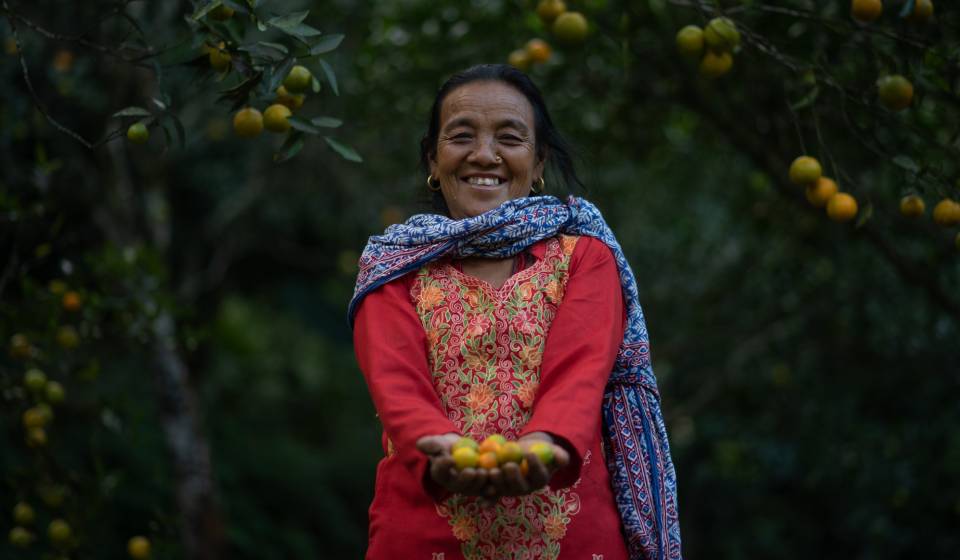
The arrival of the 15-day festival of Dashain usually marks the time to harvest Junar (sweet orange) in the high hills of Sindhuli. The citrus fruit sales is a major source of income for most of the farmers in this district which is known as a pocket-area for the production of the fruit. But time has changed for BalKumari Thapa (37) as she had to burn down her orchards.

Bal Kumari Thapa prepares lunch for her children and husband on early morning to send them to school. Ganesh Thapa (husband) of Bal Kumari is teacher at a local school.
Once filled with lush green trees surrounding her home with birds chirping and the sweet fragrance of flowers at the time of pollination, her 18 ropani (9157.27 sq meter) orchard now hosts the remains of burnt trees. All her 2,500 trees got completely wiped out as an epidemic of citrus greening swiped through her farm.
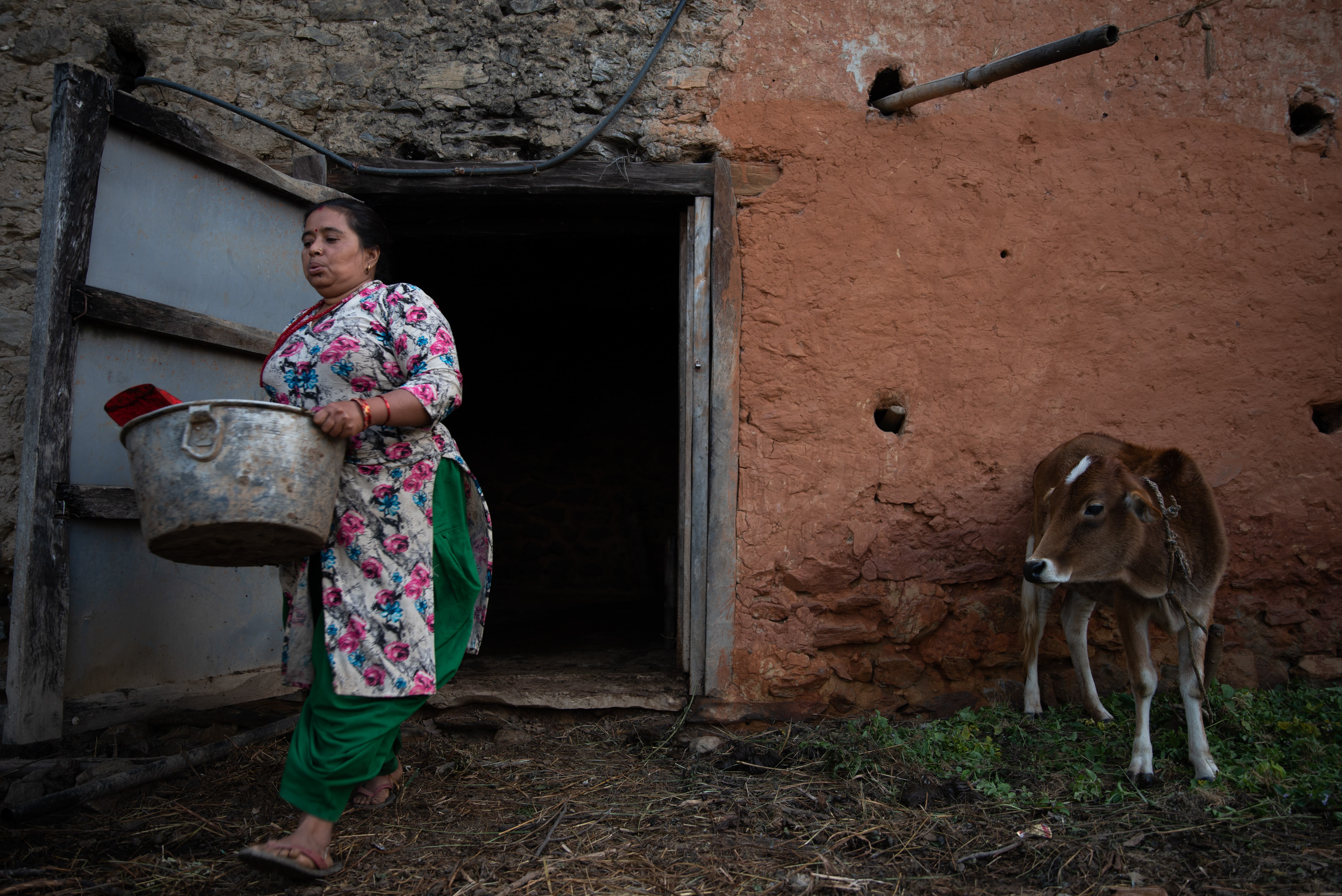
Bal Kumari Thapa exits the cowshed after cleaning it. It is her one of the first duties to complete after waking up in the morning.
“Saplings of sweet orange were planted in late 2005 and I got married and came here in early 2006. They grew up well, transforming into trees and it was high time that they could bear the fruits but at that time the trees started to wither and die,” said Thapa.

Bal Kumari Thapa holds a damaged sweet orange (Junar) that she plucked out from the infected tree.
“Officials who arrived for inspection informed us that citrus greening is responsible for the situation. Our field got attacked by a pest when we were about to start earning from it,” she said.
Huanglongbing, also known as citrus greening and locally called “Aunsa” is a devastating disease that infects citrus orchards. It has three species of un-culturable and phloem-limited bacteria out of which the most commonly found in Nepal is Candidatus Liberibacter Asiaticus which is transmitted by an insect vector.

Dream destroyed: Bal Kumari Thapa point to the plot of land where her dream of orchard use to stand green and lushy.
Thapa’s orchard also got infected by the same bacteria, hitting several economically important citrus production areas of Nepal whose cure is yet to be known. Upon finding no option other than burning down the orchards, Thapa had to witness the devastation.
“The orchards were lush green. Plantations were first done in 2005 and within 5 years the field looked very beautiful. It has been three years since I had to burn down my orchard and it looks this barren. I am in so much agony that I cannot even talk about it now. I sometimes feel like I have lost my children because I had taken so much care of the saplings right from the plantation,” Thapa said.

Still recovering: Bal Kumari Thapa weeds out the area of a remain that still remains in the plot of land where the lush green orchard use to stand before it had to be burnt down some 5 years ago.
She estimates she had to incur a total loss of about Rs 10 million due to the pathogen. In normal times, she used to earn 2 to 3 million Nepali Rupees each year from the sales of the fruits.
The Government of Nepal last decade declared the district as a “pocket area” for sweet oranges with the aim to expand the orchards as well as control the pests in the area. The main areas for the production of sweet orange are Ratanchura, Jalkanya, Tinkanya area where the contagion has spread like wildfire.

Ganesh Thapa and Bal Kumari Thapa are pictured inside their shop that latter had to start to keep herself engaged and support the economics of family. Ganesh only earns 30,000 rupees on monthly basis which as per them is not enough to fulfill the daily needs.
The district on average produces over 10,000 tons of sweet orange a year. Sitting in the lap of the Mahabharat range, the 100 kilometers area is most suitable to produce citrus fruits. A single tree found in this area can bear fruits worth Rs 1,000 to 1,500 every year. Government figures also show that 40 percent of the farmers in the district had to face huge losses due to the pathogen.

Effect of Citrus greening: Sweet orange infected with the contagion hangs on the branches of a infected tree that stand on the courtyard of Bal Kumari at Sindhuli District.
Nepali agricultural experts are not able to find the exact reason and origin of the pest in the district but they have recorded the presence of pests in higher altitude which they attribute to possible factors of climate change.

A bag containing infected sweet oranges are seen packed inside the plastic bag supplied to farmers by the government body.
The region this year also witnessed a heavy downpour in the off season which meteorologists attribute as post-monsoon climatic effect which resulted in the death of dozens across Nepal. This untimely rainfall pattern has resulted in a delay in the ripening of the fruit and loss in taste.

A orchard of sweet orange is seen in the slopes of Golanjor Village Council in Sindhuli District of Nepal.
“We don’t have proven data to claim that climate change has made an adverse effect on the production but in the lower areas at an altitude of 800 meters, the temperature is consistently increasing inviting the epidemic of pathogens which ultimately leads to the total displacement of orchards. In our survey we do have found that the vectors for the transmission of citrus greening are growing in number day by day; their number is high in the lower altitude (below 1000 meters) and continues to deplete with the rise in elevation,” said Ramesh Humagain, chief of the Prime Minister Agriculture Modernization Project in Sindhuli.
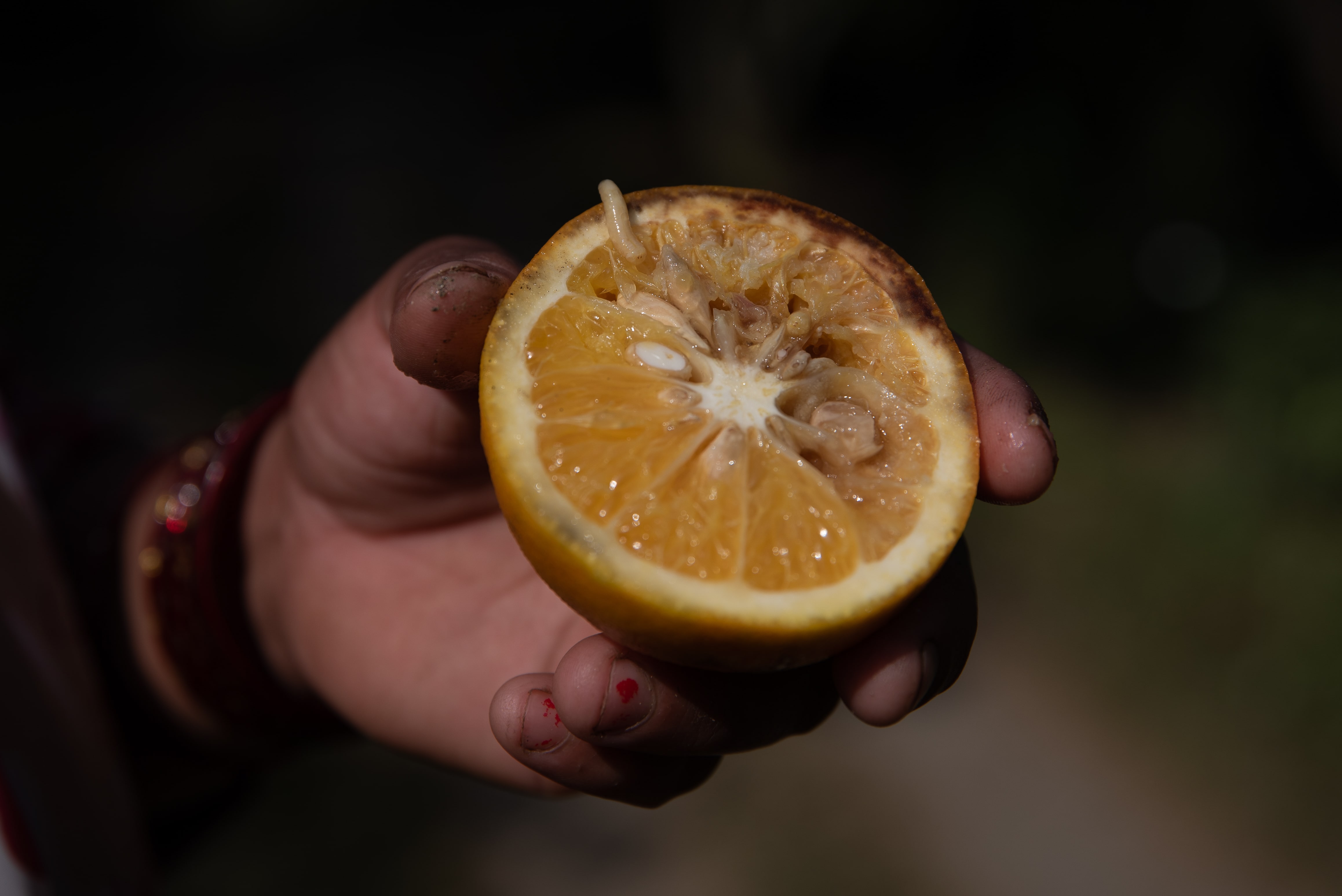
Worms are seen in a infected sweet orange as a farmer cuts it into two halves after picking it from a tree in the orchard of Bhadaure in Sindhuli District of Nepal. The Candidatus Liberibacter asiaticus has a lifecycle same like a fly which flies around infecting the citrus trees.
Based on the observation and prevailing facts, the government has decided to stop encouraging the farmers to cultivate sweet orange in altitudes of 800 to 999 meters deeming it to be prone to pathogens, the official said.
The district which has about 1,000 hectares covered by sweet orange orchards annually produces about 9,000 metric tons of citrus fruits out of which 6,000 metric tons is supplied to the market. The supply continues for about six months starting from the end of September to early April.
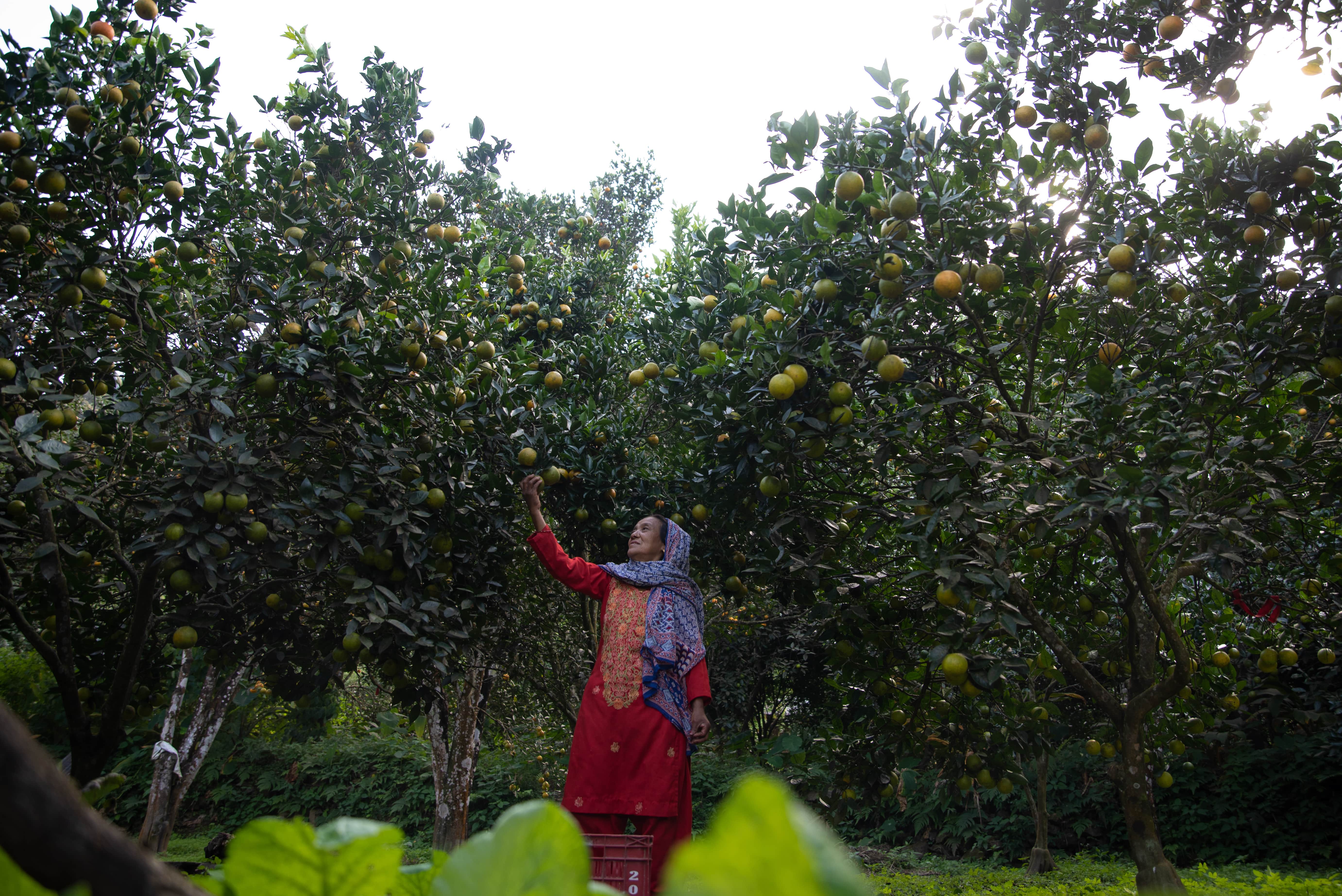
Devi Kumari Thakuri (65) plucks sweet orange from her orchard in Tinkanya of Sindhuli District which also is regarded as the pocket area for the citrus fruits.
“Untimed rainfall along with hailstone and drought has been damaging the orchards. The issue of citrus greening has increased in recent days in comparison to before. When we compare studies carried out in other countries with our observation of the pathogen that is responsible for citrus greening, we find that the citrus shellac earlier used to be found on orchards at the elevation of 800 meters but we found it above 1000 meters as well. This shows that the temperature is rising. In my personal observation, it was found at an elevation of 1100 meters in Khotang District as well as up to 1250 meters,” said Dev Raj Adhikari, Crop Protection Officer, Government of Nepal.
Nepal, home to 8 of the 10 highest mountains in the world, has recorded a steep rise in temperature between 0.3-0.7°C faster than the global average. As it impacts the higher altitudes the climatic condition in the other belts of the nation also has continued to change.
In Nepal, the first case of citrus greening was recorded in 1968 near Pokhara which since then has been recorded in most of the areas of the nation threatening the orchards.
Apart from climate change, experts opine that citrus greening is the result of disruption in the food chain of the ecosystem.
“There are some plant-friendly insects while some insects harm the plants. There is a food chain that co-exists in between them. The rise in use of insecticides and pesticides somewhat has a role to impact the chain of food which also can be considered another factor for the rise in the contagion,” Adhikari said.
Efforts to control pests
Devi Kumari Thakuri, 65, has been into the business of cultivating sweet oranges since her young age. She raised her children and sent them abroad as well as married them off from the income from orchards.
The oldest tree of sweet lime in her orchard is about 40 years old and is still giving fruits but she has seen changes in the size of the fruits the tree has been yielding.
“Still I earn about Rs 1.5 million annually from the sale of sweet oranges. Buyers come to my orchard and they take the produce. In recent years, the fruit has ripened earlier than before and the pests also have increased,” Thakuri claims.

Devi Kumari Thakuri (65) plucks sweet orange from her orchard in Tinkanya of Sindhuli District which also is regarded as the pocket area for the citrus fruits.
In her experience, the number of pests has continued to rise in the last three years. Whenever she finds the larvae of citrus shellac in any of the fruits in her orchard, she kills them so that they don’t get transferred to other healthy plants. If any of it gets missed out then it would spread out like wild-fire resulting the trees to wither out turning yellow and fruits ripening early with the covering turning thick.

Devi Kumari Thakuri (65) carries the crate containing sweet orange from her orchard in Tinkanya of Sindhuli District which also is regarded as the pocket area for the citrus fruits.
“Officials have provided us with a bag, I collect the damaged fruits and keep them in a plastic bag that is provided to us. I also have collected some larva which are kept in a bucket filled half with mud and covered by cotton cloth with mouth tightened so that it doesn’t escape. They will die in a few days, we don’t have any other option than that to save our produce,” Thakuri said, showing the plastic bags lined up in front of her house and the bucket which was filled with about 150 larvae.
Thakuri suspects the contagion was carried into Sindhuli district by a local resident who happened to bring infected citrus fruits which adapted with the climatic situation now engulfing the whole region.
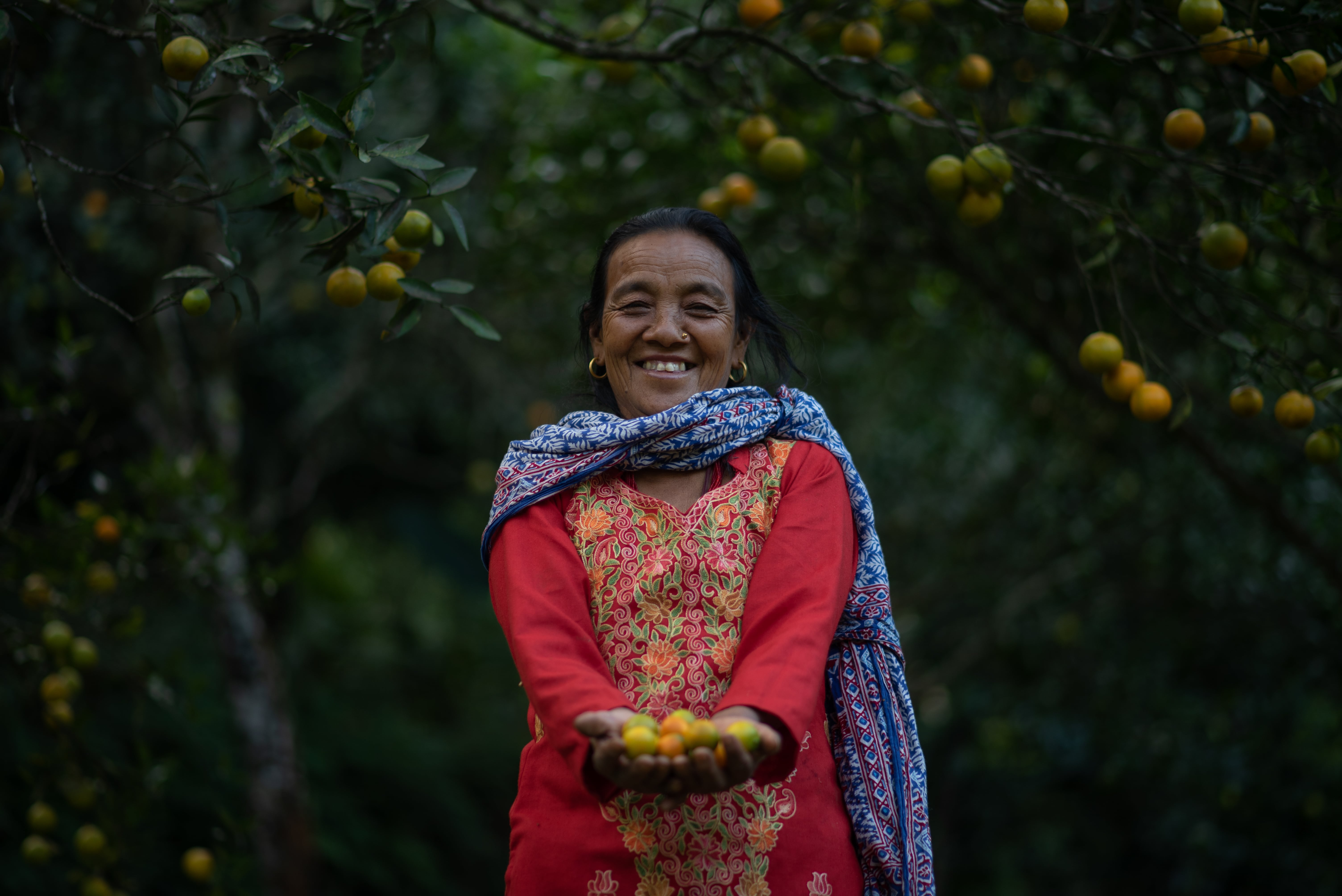
Devi Kumari Thakuri (65) shows plucked citrus fruit in her orchard in Tinkanya of Sindhuli District which also is regarded as the pocket area for the citrus fruits.
“This contagion was not present here in the past. It has been seen here recently and has engulfed the area like wildfire. We started noticing it about seven years ago. I suspect it to have been carried here by mistake from Ramechhap,” Thakuri said.

Back in home Devi Kumari Thakuri (65) shows the bucket half filled with soil containging Candidatus Liberibacter asiaticus that she found in her orchard in Tinkanya of Sindhuli District which also is regarded as the pocket area for the citrus fruits.
Changing the crop
After bearing the loss of about Rs 10 million, Balkumari is now thinking of shifting to other crops from sweet orange. She has been holding consultations with government officials, looking forward with suggestions for other cash crops which would fill the gap of economic sources after she had to burn down her orchard.

Devi Kumari Thakuri (65) marks the bucket half filled with soil containging Candidatus Liberibacter asiaticus that she found in her orchard in Tinkanya of Sindhuli District which also is regarded as the pocket area for the citrus fruits. With cure yet to be known, the farmers keep the contagion in bucket for about 2 weeks to let it die and later bury it in a hole that is at least 5 meters deep.
“We cannot leave agriculture as we have nowhere to go and we know nothing else. As we have been suggested not to cultivate sweet oranges immediately, I’ve planted potatoes, turmeric, ginger and avocado along with lemon and guava so that I can have more income,” she said.
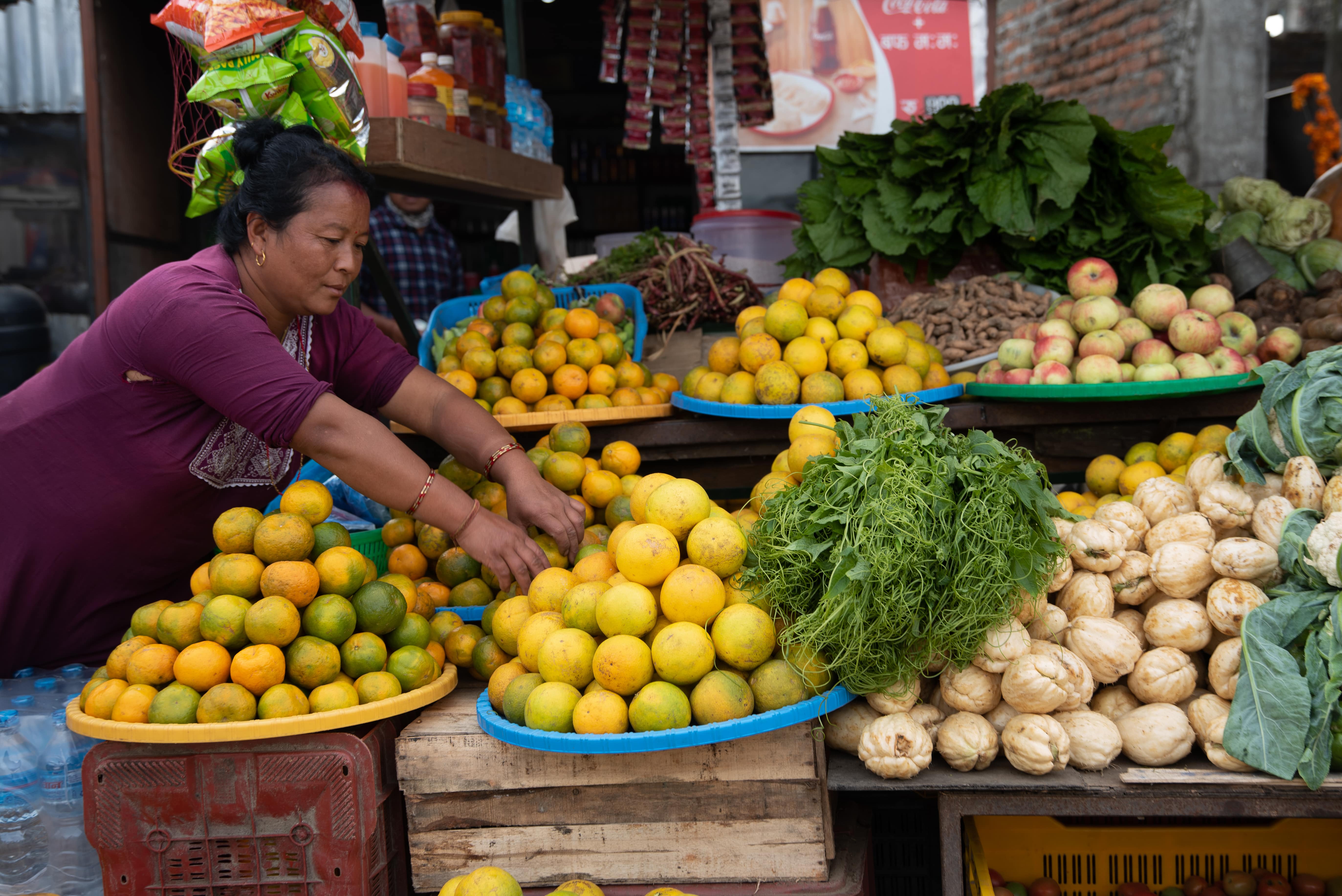
A seller arranges sweet orange in her shop at a local market in Sindhuli District.
(This report is supported by the Road to COP campaign implemented by the British Council and funded by UKAID.)
You May Like This

Storm damages mango, litchi orchards in Sarlahi
SARLAHI, May 17: Recent storms have caused huge damage to mango and litchi gardens in Sarlahi district. ... Read More...




Just In
- 550,000 people acquire work permits till April of current fiscal year
- Fixing a win by outlawing dissent damages democracy
- MoHP cautions docs working in govt hospitals not to work in private ones
- Over 400,000 tourists visited Mustang by road last year
- 19 hydropower projects to be showcased at investment summit
- Global oil and gold prices surge as Israel retaliates against Iran
- Sajha Yatayat cancels CEO appointment process for lack of candidates
- Govt padlocks Nepal Scouts’ property illegally occupied by NC lawmaker Deepak Khadka








_20220508065243.jpg)




Leave A Comment